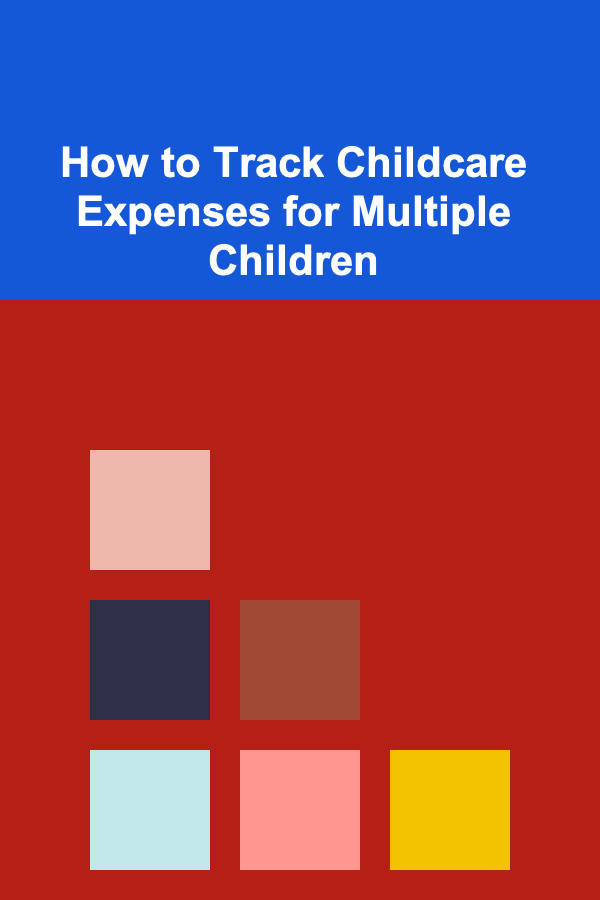
How to Track Childcare Expenses for Multiple Children
ebook include PDF & Audio bundle (Micro Guide)
$12.99$9.99
Limited Time Offer! Order within the next:

Managing childcare expenses can be one of the most significant financial challenges for parents, particularly when they have more than one child. Childcare costs vary depending on the type of care, the number of children, the location, and the age of the children. As parents or guardians of multiple children, tracking these expenses can become even more complex, but with the right strategies and tools, it is entirely manageable.
This article will explore various methods for tracking childcare expenses for multiple children, offering detailed insights into budgeting, organization, and financial planning. We will also discuss how technology, tools, and strategies can help you streamline the process and avoid feeling overwhelmed by the financial responsibilities that come with raising children.
Why Tracking Childcare Expenses is Important
Before diving into the "how," it's essential to understand why tracking childcare expenses is important, especially for families with multiple children. Childcare can often become one of the largest household expenditures, particularly if both parents are working full-time or if they need specialized care for children with special needs. Here's why careful tracking matters:
- Financial Planning and Budgeting: By keeping track of childcare expenses, you can better plan your budget and adjust for any changes, such as a rise in childcare costs or a change in the number of children requiring care.
- Tax Benefits: Many governments offer tax credits or deductions for childcare costs. Tracking your expenses ensures that you can take full advantage of these financial benefits.
- Cost Comparison: With multiple children, it's easy to lose track of the cost for each child. Tracking your expenses helps you understand how much you're paying for each child and whether any adjustments are needed.
- Savings for the Future: By understanding your childcare costs, you can allocate funds for future expenses, including potential changes in childcare needs as your children grow older.
Now that we understand why tracking childcare expenses is important, let's explore practical methods to track these costs.
Create a Budget for Each Child
The first step in tracking childcare expenses for multiple children is to create a budget for each child. Each child may have different childcare needs and associated costs, depending on factors such as:
- Age: Infants or toddlers generally require more intensive care, which can drive up costs compared to older children who may only need part-time care or after-school programs.
- Type of Care: The cost of childcare can vary depending on whether it's a daycare, private nanny, preschool, or after-school program. Each care provider will have different pricing structures.
- Number of Hours: Childcare costs can depend on how many hours of care are needed, whether it's full-time, part-time, or intermittent.
Actionable Steps:
- List Each Child's Needs: For each child, outline their childcare requirements. Are they in daycare? Do they have a nanny? Are they in after-school care? How many hours per week are they in care?
- Allocate a Monthly Budget for Each Child: Based on the information above, create a separate budget for each child that reflects their childcare expenses.
For example, one child might require full-time daycare costing $1,000 a month, while another child might only need after-school care at $300 per month.
Use Expense Tracking Tools or Apps
In the digital age, expense tracking apps and tools can simplify the process of monitoring and organizing childcare expenses. There are numerous apps designed specifically for managing household finances, and many offer features that allow you to track individual expenses per child.
Recommended Apps:
- Mint: Mint is a popular free app that allows you to link your bank account and credit cards to track all expenses. You can create specific categories for each child and track how much you're spending on childcare for each.
- Expensify: Expensify is an excellent tool for capturing receipts and categorizing expenses. You can easily categorize childcare expenses for each child and add notes about the services.
- YNAB (You Need a Budget): YNAB helps you create specific budgets for each child and categorize childcare costs accordingly. It can also help you adjust and reallocate funds when needed.
- GoodBudget: GoodBudget is a simple-to-use app that allows you to create virtual envelopes for each child's expenses, helping you track where your money goes for childcare.
By using an app or software, you can easily track your expenses in real-time, ensuring that you're never left guessing how much you've spent.
Categorize Your Childcare Expenses
When you have multiple children, it's crucial to categorize your childcare expenses. While the general childcare category might include the base cost of daycare or nannies, breaking the expenses down into subcategories can provide a clearer picture of where your money is going.
Common Categories for Childcare Expenses:
- Tuition Fees: This includes daycare tuition or school fees for children attending full-time daycare or preschool.
- Part-Time Care: Expenses for part-time care, such as after-school programs or care during weekends.
- Nanny or Babysitter: If you employ a nanny or babysitter for one or more of your children, this should be a separate category.
- Emergency Care: This includes any unplanned childcare expenses, such as hiring a last-minute babysitter.
- Extracurricular Activities: If your children are involved in extracurricular activities such as sports, music lessons, or other special programs, these should also be tracked.
Categorizing your expenses ensures that you're aware of the cost breakdown for each child. For instance, if you have one child in daycare full-time and another in after-school care, you can easily see how each child's expenses differ.
Track Receipts and Payments Regularly
Staying on top of receipts and payments is essential to tracking childcare expenses accurately. Whether you pay for childcare monthly, bi-weekly, or as a lump sum, it's important to record and store these payments in an organized manner.
Tips for Tracking Receipts and Payments:
- Store Receipts Electronically: Use apps such as Evernote or Google Drive to take pictures of your receipts or upload digital invoices. This will help you keep all your receipts in one place.
- Schedule Regular Checks: Set aside time every week or month to review your childcare expenses. This allows you to identify any discrepancies early and ensure that your expenses align with your budget.
- Use Bank Statements: For recurring expenses, such as daycare tuition or nanny salaries, your bank statements can serve as a reference point. Ensure the amounts match what was agreed upon with your childcare provider.
Consider Using a Dedicated Childcare Account
Some parents find it helpful to create a dedicated childcare account for their children. This could be a separate bank account that is specifically used for childcare expenses, which makes tracking much easier.
By keeping your childcare expenses in a separate account, you eliminate the possibility of mixing them up with other household expenses. Additionally, this allows you to see how much you're spending on childcare month-to-month without the distraction of other expenses.
How to Set Up a Dedicated Childcare Account:
- Open a Separate Account: Choose a checking or savings account that you can use exclusively for childcare expenses.
- Automate Payments: If possible, set up automatic payments from your main account to the childcare account. This will ensure that your payments are consistent and that the funds are available when needed.
- Monitor Spending: Review your childcare account regularly to track expenses and ensure you're staying within your budget.
Keep Track of Tax-Related Childcare Costs
In many regions, childcare expenses are eligible for tax credits or deductions. In order to claim these benefits, it's essential to keep track of your childcare costs throughout the year.
How to Track Tax-Eligible Childcare Costs:
- Save All Receipts: Keep copies of invoices, receipts, and any documentation from your childcare providers. These will be necessary when filing taxes.
- Categorize Tax-Eligible Expenses: Some expenses, like daycare tuition, are tax-deductible. However, costs such as meals or travel may not qualify. Make sure to separate these categories when tracking.
- Consult a Tax Professional: If you're unsure about what is tax-deductible, consider consulting with a tax professional to ensure you're maximizing your benefits.
Review and Adjust Your Budget Regularly
As your children grow and their childcare needs change, it's important to review and adjust your budget regularly. The cost of childcare will vary over time, especially as children age and may transition from full-time care to part-time care or after-school programs.
How to Adjust Your Childcare Budget:
- Re-evaluate Yearly: At least once a year, sit down and review your childcare budget to ensure it reflects your current needs.
- Adjust for Increases: If your childcare provider increases rates, adjust your budget to reflect this change. Similarly, if your children become eligible for cheaper care options as they grow, adjust your budget accordingly.
- Plan for Future Needs: Think about your children's future care needs. Will they need tutoring, summer camps, or after-school programs? Adjust your budget to accommodate these future expenses.
Regularly reviewing and adjusting your budget helps you stay in control of your childcare costs and avoid unexpected financial burdens.
Involve Your Partner in Tracking Expenses
When managing childcare expenses for multiple children, it's essential to involve your partner or spouse in the tracking process. Keeping both partners informed helps reduce confusion and ensures that financial responsibilities are shared.
Tips for Involving Your Partner:
- Set Up a Shared Budget: Use apps like Mint or YNAB to create a shared budget that both you and your partner can access.
- Schedule Family Financial Meetings: Set aside time each month to review your family's finances together, discuss childcare costs, and ensure that you're on track with your budget.
- Divide Responsibilities: If you're both responsible for different aspects of childcare, divide the tasks so that one person isn't overwhelmed. One partner might handle daycare payments, while the other manages after-school care expenses.
Collaborating on childcare expenses ensures that both partners are aligned and can help identify potential savings or improvements to your financial situation.
Conclusion
Tracking childcare expenses for multiple children requires careful planning, organization, and consistency. By creating a clear budget for each child, using tools to track expenses, categorizing your costs, and staying on top of receipts and payments, you can effectively manage the financial aspect of childcare. Moreover, taking advantage of tax benefits, adjusting your budget regularly, and involving your partner will ensure that your childcare expenses remain manageable and within your financial means.
While managing these expenses might seem overwhelming at times, with the right tools and strategies, you can turn the process into a routine that provides peace of mind and financial stability as you navigate the challenges of raising multiple children.
Reading More From Our Other Websites
- [Personal Investment 101] How to Invest in Startups: A Beginner's Guide to Early-Stage Ventures
- [Home Space Saving 101] How to Transform Your Small Entryway into a Functional and Stylish Space
- [Home Maintenance 101] How to Ensure Electrical Wiring Safety in Your Older Home: A Step-by-Step Guide
- [Home Budget Decorating 101] Best Farmhouse Budget Decorating: Rustic Charm on a Realistic Home Budget
- [Home Renovating 101] How to Transform Your Bedroom on a Budget: Creative Makeover Ideas
- [Home Budget 101] How to Plan for Home Repairs and Unexpected Expenses
- [Trail Running Tip 101] From City Streets to Forest Paths: Transitioning to Trail Running Safely
- [Organization Tip 101] How to Use Bins and Baskets for Trunk Organization
- [Rock Climbing Tip 101] Strength, Flexibility, and Endurance: How Climbing Transforms Your Body
- [Tiny Home Living Tip 101] Best Tiny Home Lighting Ideas to Enhance Small Spaces

How to Create a Disaster Recovery Checklist for Remote Work Environments
Read More
How to Freshen Up Your Home with Simple Cleaning Hacks
Read More
How to Incorporate Modern Design Trends in Your Home Staging
Read More
How to Manage Guest List and RSVPs Efficiently
Read More
How to Store Clothes Efficiently in Small Closets
Read More
How to Integrate Smart Home Tech into Your Renovation To-Do List
Read MoreOther Products

How to Create a Disaster Recovery Checklist for Remote Work Environments
Read More
How to Freshen Up Your Home with Simple Cleaning Hacks
Read More
How to Incorporate Modern Design Trends in Your Home Staging
Read More
How to Manage Guest List and RSVPs Efficiently
Read More
How to Store Clothes Efficiently in Small Closets
Read More